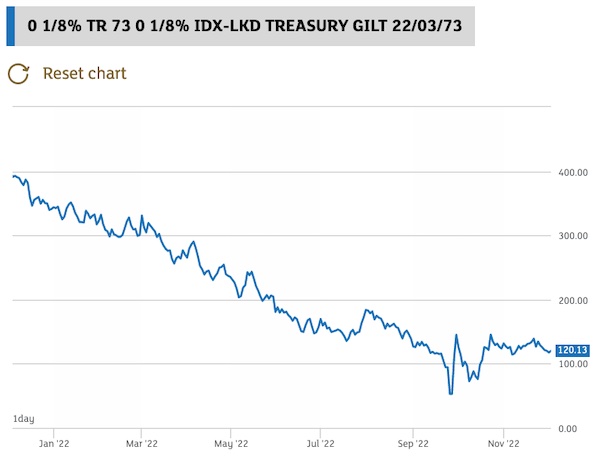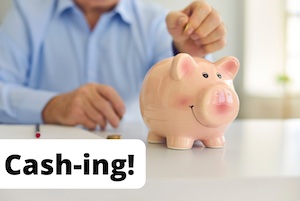What were you doing on 23 September 2022?
If you are a druid, perhaps you were recognizing the Autumn Equinox? K-pop superstars Blackpink were celebrating their first UK number one.
For my part I was trying to divine the thinking behind Liz Truss and Kwasi Kwarteng’s freshly-delivered fiscal plans.
Mini Budget Day! Only a couple of months ago, but already it feels like a fevered dream. Indeed when I reread my report on what I then called the ‘Push-Me-Pull-You’ budget, I see I illustrated it with a strange two-headed beast.
That image appears only more appropriate with hindsight. Because the Mini Budget put UK capital markets into Nightmare Mode.
Investors took fright as the cavalier direction of British politics since 2016 reached its financial apogee. Any merits – and there were some – to the focus on economic growth were entirely overshadowed by our latest leaders making plain their disdain for convention and restraint.
Gilts fell, as did the pound. Pension funds caught offside liquidated holdings. Assets went into a tailspin. There were fears of a Death Spiral. A fire sale of Britain’s fiscal silverware that would force still more selling, metastasizing the crisis until it even threatened the banks.
We’d been there once before this century. Nobody wanted another T-shirt.
Fortunately Britain’s biggest bank was having none of it. The Bank of England stepped in to shore up the system – yet it defied the shrieks from certain perma-delusional Brexiteers and warned its support was temporary. The Old Lady was not going to monetize the bill for Basket Case Britain.
But something had to give, and it turned out to be the chancellor – followed by the Prime Minister. In a month Britain had new iterations of both, this time singing from a more conventional hymn sheet.
The Tories were chastened. They would do anything to get off the naughty step.
The markets believed them and the stresses in the system melted away.
How the bodies were buried
Given all the high drama – and the uncomfortable optics of bond vigilantes and arguably even the Bank of England governor forcing political change – what is most remarkable just ten weeks later is how much the damage has been repaired. At least from the perspective of the City of London.
Look at the bond markets and you’d never know it happened. The pound is up a lot. Market trading is orderly. And if any big beasts were fatally wounded by the ructions then we’ve yet to find out.
It’s a slightly different story for us little guys though – especially those of us with mortgages.
Let’s take a ride through the scenic route to see just how acute the episode was.
Index-linked government bonds, aka index-linked gilts, aka ‘linkers’
When I do my retrospective of the 2020s in eight year’s time (put it in your calendars, Monevator fans) index-linked gilts will be the poster child for the Kwamakazi experience.
I’ve already shared this Tweet from the height of the crisis:
It’s still hard to believe that index-linked gilts – supposedly the most staid asset class in a UK investor’s toolbox – fell so precipitously. That’s forced selling for you.
The longest-dated linkers saw the most dramatic declines. That iShares ETF has sported a duration of around 20 for most of 2022 (duration has declined as yields have risen) but there exists an index-linked gilt that won’t mature until 2073. Its duration is nearly 50!
The price decline for that one has been absolutely brutal this year:

Yet in a reminder that things can always get worse in investing, even after its price had fallen by two-thirds in 2022, this linker still almost halved again following the Mini Budget.
Shocking – yet those of you with your glasses on might also notice the price is now back above where it sat on 23 September. The painful event has been erased.
Blink and you missed it
Returning to the iShares ETF tracker INXG, its price is now back to bouncing around just below £15.
Anyone brave enough to buy in the maelstrom might have seen a 35% gain in a matter of weeks. This from one of the world’s supposedly dullest investments, and in an awful year for profitable investing.
Moreover for a heady moment in late September you could buy a 30-year linker with a positive real yield of 2%. That’s like buying a £2,000 annuity for £100,000 – but without giving up your capital!
Me and The Accumulator started exploring index-linked gilt ladders that could create a near-risk-free retirement portfolio with a nailed-on Safe Withdrawal Rate.1 We almost wrote about it.
But then, in a flash, the Bank of England’s interventions worked and real yields on linkers went negative once more. Not as bad as 12 months ago, but you were paying for inflation protection again.
Prices have actually eased a little since then, but nothing like enough to make index-linked gilts screaming buys. Most linkers are back on slightly negative yields to maturity. The asset is once more just an expensive but uniquely diversifying component to add to a well-rounded portfolio.
We’ve written quite a bit recently about how and why bonds have moved if you need more.
Conventional gilts
I have never fielded so many questions and opinions from friends and Monevator readers about bonds as this year.
Strange in a way, given that the scene was set by the previous ten years. But most people didn’t seem to think about where their almost metronomic bond returns came from as yields fell and prices rose for a decade.
Frogs were boiled and we forgot how weird really low interest rates were. And anyone who did ever wonder whether yields were finally turning was soon slapped in the face by market reality, as bonds relentlessly refused to crash.
But 2022 has changed all that. From a UK perspective, the Mini Budget crisis was peak Bondageddon.
I know you’re supposed to illustrate this with yields and I will in a moment. But as we’re private investors around here, let’s see how the iShares Core Gilt ETF price has done since June:

Source: Hargreaves Lansdown
For sure it had been falling ahead of that fateful 23 September. But the big lurch down you see – to £9.56 a share, per Hargreaves Lansdown – occurred in the week after Kwarteng spoke.
The price is now back around £11.
The moves have not been as dramatic as for linkers, and on the face of it there’s more value around in the conventional gilt market. Most issues are still priced below par after 2022’s declines, and it’s easy to get a 3% or higher yield to maturity. (Even the iShares ETF will give you that).
Of course, there aren’t supposed to be ‘bargains’ in the super deep gilt market. So if these bonds do look slightly better value than linkers, it may be because they are telling us something about inflation.
On the other hand maybe pension funds have to replenish their index-linked store cupboards and they don’t mind overpaying.
For a moment the Mini Budget made bonds a bargain
Either way, an attractive 4.5% yield on a 10-year gilt was a blink and you missed it Mini Budget moment:

Source: MarketWatch
I have an investing-savvy friend who got interested in bonds for the first time in his life when the yield breached 4%.
My friend has nine years left on a ten-year fixed-rate mortgage deal. From memory, his rate is a little over 2%. Even as he was helping his kids pack for a holiday, my chum was looking to rejig his portfolio to liability-match away some of that mortgage risk and profit from the 2% differential.
But he snoozed and he – ahem – loozed.
(Probably not in practice, as my friend bunged the earmarked money back into a hedged global tracker in the end, which is likely to do far better over nine years. But it will be a very different ride.)
Bonds still look more attractive than they have for years. However that’s a low bar. On these yields they are fine assets for diversification, but I wouldn’t go overboard, personally, and would favour a good slug of cash in the mix.
Mortgage madness
Discussion of bonds and yields moves us naturally on to mortgages. And here the damage inflicted by the Mini Budget has yet to be entirely ameliorated.
Sure, mortgages don’t move in lockstep with bond yields. They are more determined by so-called ‘swap’ rates.
Swaps are basically ways in which financial institutions transform and trade different kinds of interest rate risk to suit their needs.
Swap rates are mostly determined by the yield curve, as are bond yields, so it’s all relevant. (Some people will tell you it’s all the same thing – ‘interest rates’ – but I prefer to think of a kind of Platonic yield curve that all these variables are oscillating around. But we’re getting into the weeds…)
Banks consider more than the prevailing swap rates when pricing their mortgages. They also take into account how risky they feel the lending landscape is, and how much business they want to do.
And during the Mini Budget mayhem, they pretty much decided ‘sod all’ was the appropriate level.
Fixed-rate mortgages skyrocketed as swap rates spiked. Hundreds of mortgage products were pulled.
The following graphic shows how mortgage rates were slow to follow swap rates back down. (It will be particularly interesting to the finance wonk reader who even now is furiously typing a comment in response to my earlier broad-brush descriptions. You see? Swap rates aren’t actually everything):

Source: Reuters
Rates up, prices down: for bonds and maybe houses too
The good news is fixed mortgages rates have declined further in the month since that graphic was created.
Just last week the rate on a five-year fix fell below 6% for the first time since October.
The bad news is these rates are still much higher than before 23 September. Not only has that caused lots of people to lock into higher mortgages than they otherwise would have, it’s also dinged the housing market.
This shouldn’t be surprising given the hit to affordability of going from 2% to 6% on today’s huge mortgages. (Although it does seem to come as a surprise to many Boomers still dining out on their far higher rates – but much lower balances – of 30 years ago.)
I wonder if doing the sums on higher rates will have a lasting affect on home buyers, even if rates continue to decline. Perhaps they have looked into the abyss of potentially needing to sell a kidney to meet their mortgage payments and pulled back?
Lower mortgage rates would still be welcome, even if it’s too late to prevent a hit to house prices. Consumer spending will need all the help it can get in 2023.
The Pound
Much was made in the midst of the Mini Budget brouhaha of the decline in the value of Sterling. Hardly surprising, given the exchange rate almost touched $1.03 on the following Monday.
However it always takes two to tango with exchange rates – since they must be quoted in pairs.
Sure, some of the decline in the pound reflected international capital calling time on Britain’s political antics. But a fair bit of it was dollar strength.
Here’s how the pound has fared against the dollar and the Euro over the past six months:

Source: Google Finance
You can see a late September swoon against both the Euro (yellow) and the dollar (blue). But the move against the greenback is swoonier. Other things were going on at the time that made the US dollar even more attractive.
You’ll also note the pound is now back above pre-Mini Budget levels against both currencies.
Tomorrow I’ll wake up in the shower and realize it was all a dream.
The Mini Budget and pensions
Other lingering impacts? What about pensions and all that Liability Driven Investing (LDI) business?
Some experts reckon there has been a long-term hit to the funding of some pension schemes from their forced selling in September.
Professor Iain Clacher told MPs last week there was “probably £500bn missing somewhere” :
“This is not a paper loss, this is a real loss, because pension funds were selling assets to meet their collateral calls.
What we’ve actually seen is a significant reduction in the overall pot of assets that are available to pension funds to pay pensions in the fullness of time.”
That seems to make sense. It’s also plausible that nobody has made much fuss about it, because scant few of us really understand pension funding and many schemes were in deficit for years anyway.
Pension schemes affected by LDI might well want to avoid spooking their members – and regulators – unless and until they have to. (Higher yields in 2022 had previously improved the funding picture, which will help.)
But a potential portent of real damage came just yesterday. According to the Financial Times:
Lloyds Banking Group’s pension scheme sold billions of pounds of assets to meet collateral calls during September’s market crisis, one of the biggest known sell-offs by a corporate plan.
Details of the scale of asset disposals were revealed in a submission made to the work and pensions select committee by the partner of the head of Lloyds’ £52bn retirement scheme.
In evidence to MPs, Henry Tapper, founder of AgeWage, which provides pension market analysis, said he lived with the chief executive of a large defined benefit plan […]
“Much of the money posted as collateral won’t be seen again, the assets of the scheme are depleted and much money has been spent in the liquidation process,” wrote Tapper. “I understand the scale of the collateral call ran into billions of pounds.”
Tapper’s partner, Stella Eastwood, is reportedly head of pensions at Lloyds. The FT reports that Lloyds’ three defined benefit plans have around 47,000 members.
Waking up from the Mini Budget blues
Sitting here at the start of December, the Mini Budget feels like a nasty disease we got through.
The symptoms have mostly gone away. But it knocked us back and we still don’t feel quite right.
The economy is headed for recession. It was probably going that way anyway. But the rise in borrowing costs has likely nailed it on.
Overall I think Britain dodged a bullet. You can imagine scenarios where the markets weren’t so quickly calmed. Maybe if the Tories hadn’t got their act together with that solid Mr Hunt, or if the Bank of England had dithered.
Nobody likes austerity much – touted as the main political fallout from this strange roundabout trip. Although as things stand austerity is mostly still a future promise, perhaps made more to calm the markets than for a manifesto.
It’s also hard to foresee a risky agenda focused on growth and productivity being tried again anytime soon. A shame because we need both.
But we’ll have to take our lumps if the alternative would have been a lasting meltdown.
- I say ‘nearly’ risk-free because unlike US TIPS our linkers do not have zero floor in case of deflation. [↩]






